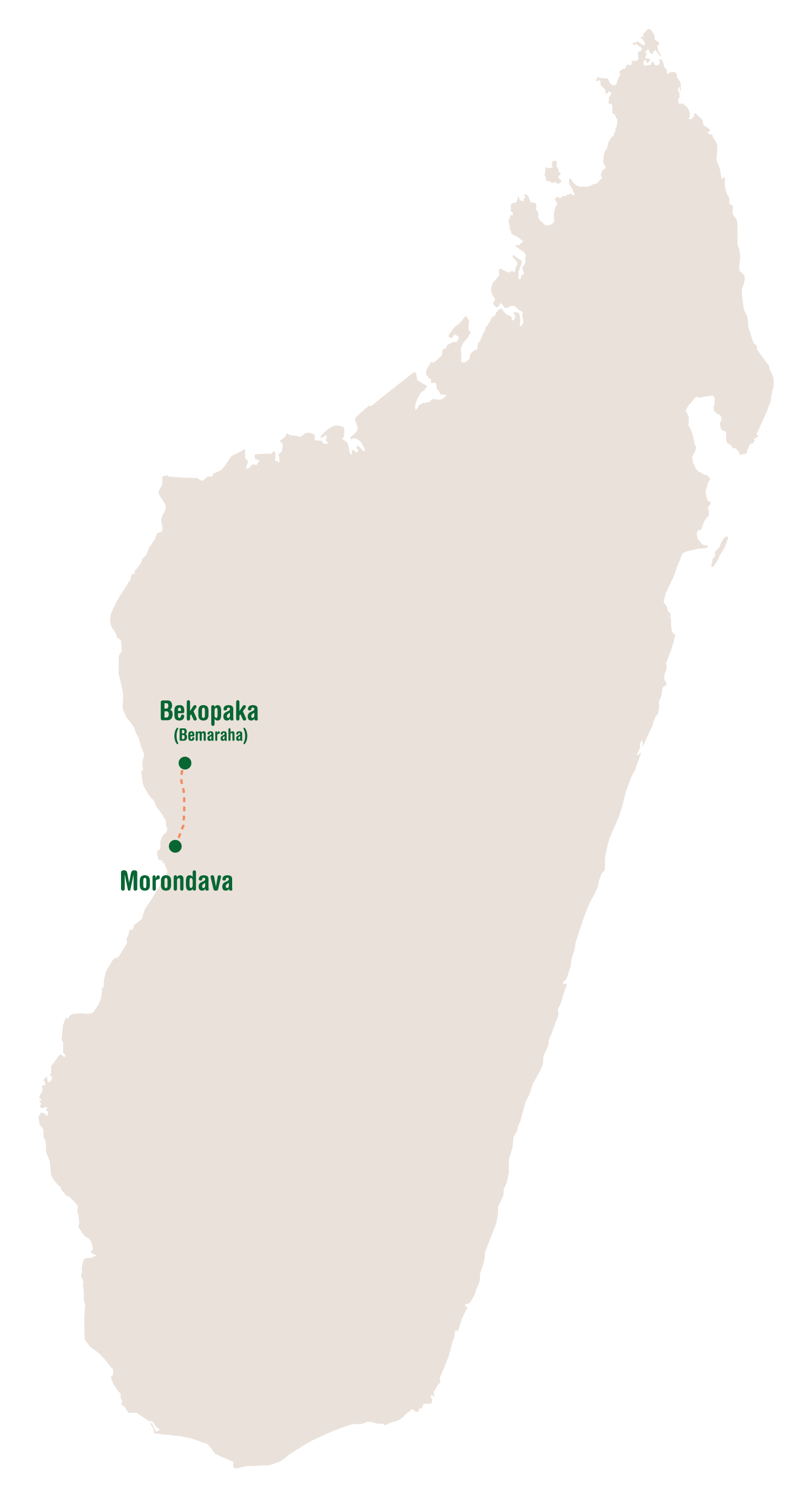The spectacular mineral forest of Tsingy de Bemaraha stands on the western coast of Madagascar. Tsingy is the Malagasy word for “walking on tiptoes” and the nearly impenetrable labyrinth of limestone needles justifies this name. The whole protected area, designated a World Heritage Site by the UNESCO in 1990, comprises a surface of 1.575 km². This remote area was not a tourist trek until 1998, when the southern part (723 km²) was declared a National Park. The northern section is an Integral Reserve so tourists are not allowed to enter the zone. The reserve’s canyons, gorges, undisturbed forests, lakes and mangrove swamps display an astonishing richness of fauna and flora which have not been completely recorded. The rate of endemism is about 85%, and 47% are even local endemic!
The limestone seabed rose to create a plateau around 200 million years ago, which was little by little eroded by heavy rainfalls until it became its actual shape. This massif is delimited to the east by the abrupt Bemaraha Cliffs, which rises some 300 to 400m above the Manambolo River valley and extends several tens of kilometres from north to south. The western slopes of the massif rise more gently, and the whole western region of the reserve forms a plateau with rounded hillocks which slope away to the west. To the north undulating hills alternate with limestone extrusions, while in the south extensive pinnacle formations make access extremely restricted. In the south of Petit Tsingy is the spectacular Manambolo Gorge where you can see waterfalls, lemurs and magnificent untouched forests. Despite the inaccessibility of the area, this park is more and more part of tour operator programs.
The flora has a high local endemism rate. The western part is principally covered by deciduous dry forests, which are particularly well adapted to the extreme changing climate conditions of the area. The eastern section is formed by grassy savannas and lowland bushes. Inside the canyons we find small areas of dense tropical forests and lianas, since it is very humid among the tall tsingy formations.
Visitors can spot 11 lemur species, including for Decken’s sifaka, red-fronted brown lemur, fat-tailed dwarf lemur, grey mouse lemur or the Cleese’s woolly lemur and the Sambirano lesser bamboo lemur, which only occur here. Other resident mammals are the small carnivorous falanouc and ring-tailed mongoose, and several bats.
More than 100 bird species have been catalogued at present inside the National Park, including the critically endangered Madagascar fish eagle and crested ibis, Madagascar wood-rail, giant coua or Coquerel´s coua.
The 45 reptiles and amphibians which are found here are all endemic. Some significant species which only occur in Bemaraha are the Madagascar iguana, a local endemic long-tailed skink and the Antsingy leaf chameleon.
Generally most visitors coming to the park usually stay over three nights to explore this unique and amazing place. A recommended plan would be:
Day 1: Petit tsingy: this circuit of 4-5 hours of duration passes through a labyrinth of limestones and two view points over the impressive pinnacles. There are some good chances to spot the Decken’s sifaka and red-fronted brown lemurs. Manambolo gorge: It is a canoe trip along the gorge combined with an easier path through caves, stalactites, stalagmites and the famous family tomb of the Vazimba tribe.
Day 2: The big Tsingy: This is probably the most rewarding whole-day trip within the park as it goes deep into the limestone forest passing through several hanging bridges with the impressive karstic formations below your feet. The trail is not technically difficult and even children can cope with it, but you certainly should not suffer from vertigo! The look down from the hanging bridge is something to avoid for the easily fainted.
Morondava (Google Map)
The spectacular mineral forest of Tsingy de Bemaraha stands on the western coast of Madagascar. Tsingy is the Malagasy word for “walking on tiptoes” and the nearly impenetrable labyrinth of limestone needles justifies this name. The whole protected area, designated a World Heritage Site by the UNESCO in 1990, comprises a surface of 1.575 km². This remote area was not a tourist trek until 1998, when the southern part (723 km²) was declared a National Park.
Departure in a 4WD car through the southern plateau, through cultivated fields and the typical villages of the Merina people, an Asian ethnic group, stopping off in the city of Ambatolampy, which is renowned for its many aluminium workshops making cutlery and cooking pots; arrival in Antsirabe and lunch in a typical restaurant; afternoon devoted to the visit of Antsirabe, the third largest city in Madagascar and the capital of the Vakinankaratra region; situated at 1500 m. asl, enjoying a cool and healthy climate, the town is characterised by a multitude of posy, rickshaw; in the evening, dinner and overnight in hotel Couleur Café (standard room) or similar.
After breakfast, continuing west through bucolic scenery of cultivated fields, in the plains and in terraces on the hillsides; up ahead the road lead to a scarcely-populated mountain region of harsh landscapes, until finally reaching the large village of Miandrivazo, on the Mahajilo river; lunch in restaurant; after that continuing along the track that first crosses the savannah and the sandy bush; then the journey continues through verdant valleys, arriving at Morondava at the end of the day, where the first gigantic baobab trees can be observed; in the evening, dinner and overnight in hotel Palissandre Cote Ouest Resort (standard room) or similar.
After breakfast, departure by 4WD car along the “Baobab Way”, where the red laterite trail crosses the verdant savannah, studded with countless gigantic baobabs; exploration of the region, of the villages of the Sakalava ethnic groups and their characteristic funerary constructions painted in vivid colours; visit to the Kirindy Reserve, to observe various species of lemur and birds in their natural habitat; picnic lunch during the excursion; return at the end of the day, with a stop in the savannah to admire the fantastic ochre-red colours taken on by the baobabs at dusk; in the evening, dinner and overnight at the hotel Palissandre Cote Ouest Resort (standard room) or similar.
Leaving the paved road, the laterite track heading south is taken through the bush, intersecting with numerous rivers which are crossed in cars; you can admire beautiful scenery of tropical forest all along the way and many baobabs of course; arrival at the end of morning to the coast near the Vezo village of Belo and settle down in hotel Ecolodge du Menabe (standard room) or similar; after lunch there will be visits to the village where numerous craftsmen can be seen manufacturing the botry, the typical boats of the region; time at your disposal to enjoy the serenity on the beach; in the evening, dinner is served and the night is spent in hotel.
After breakfast, the journey continues south along the track that crosses tropical forests, where mighty baobab trees can be observed along with typical animals like iguanas, geckos, uroplatus; picnic lunch on the road and arrival in the afternoon to the campsite; there will be time to explore the area where there is an atmosphere of great calm and the opportunity to meet the welcoming Sakalava people in nearby villages; Later in the evening, a dinner camp will be served and the night spent under canvas.
Breakfast at the camp, the continuation on the track towards Mangoky river; crossing the river by barge, then the road leads through the savannah where you can admire more species of baobab, until the coast and the city of Morombe, the main centre of the Vezo ethnic group; after lunch in a restaurant, we continue along the track until reaching one of the most beautiful beaches in Ampasilava, which also marks the beginning of the great Coral Reef of Madagascar; settling at a nearby hotel Laguna Blu (standard room) or similar; there will be free time to bathe in the soft, lapping waters of the reef; in the evening, dinner and overnight in hotel.

